Managerial Accounting: A Report on Budgeting Approaches Analysis
VerifiedAdded on 2023/06/03
|17
|4144
|412
Report
AI Summary
This report delves into the concept of budgeting within managerial accounting, providing a literature review and analysis based on two journal articles. The articles explore traditional budgeting methods and newer approaches, including a case study of Mainfreight, which operates without traditional budgeting, and an examination of public budgeting practices. The report discusses the purpose of these studies, highlighting their research questions related to the effectiveness of different budgeting approaches and their alignment with current theories. Similarities and differences between the studies are analyzed, focusing on the role of budgeting in management control systems and public organizations. Finally, the report identifies four key lessons learned from the research findings that could be valuable for management accountants in Australian companies, emphasizing the importance of cost control, financial planning, and strategic resource allocation.

Managerial Accounting
Paraphrase This Document
Need a fresh take? Get an instant paraphrase of this document with our AI Paraphraser

MANAGERIAL ACCOUNTING: 1
Executive summary
This report discusses about a concept of a budgeting as an accounting method. It has a
literature review of the topic with the relevant analysis of the topic through journals. These
two articles, which are chosen for the analysis focuses on the concept of traditional budgeting
and new approaches of budgeting.
Executive summary
This report discusses about a concept of a budgeting as an accounting method. It has a
literature review of the topic with the relevant analysis of the topic through journals. These
two articles, which are chosen for the analysis focuses on the concept of traditional budgeting
and new approaches of budgeting.
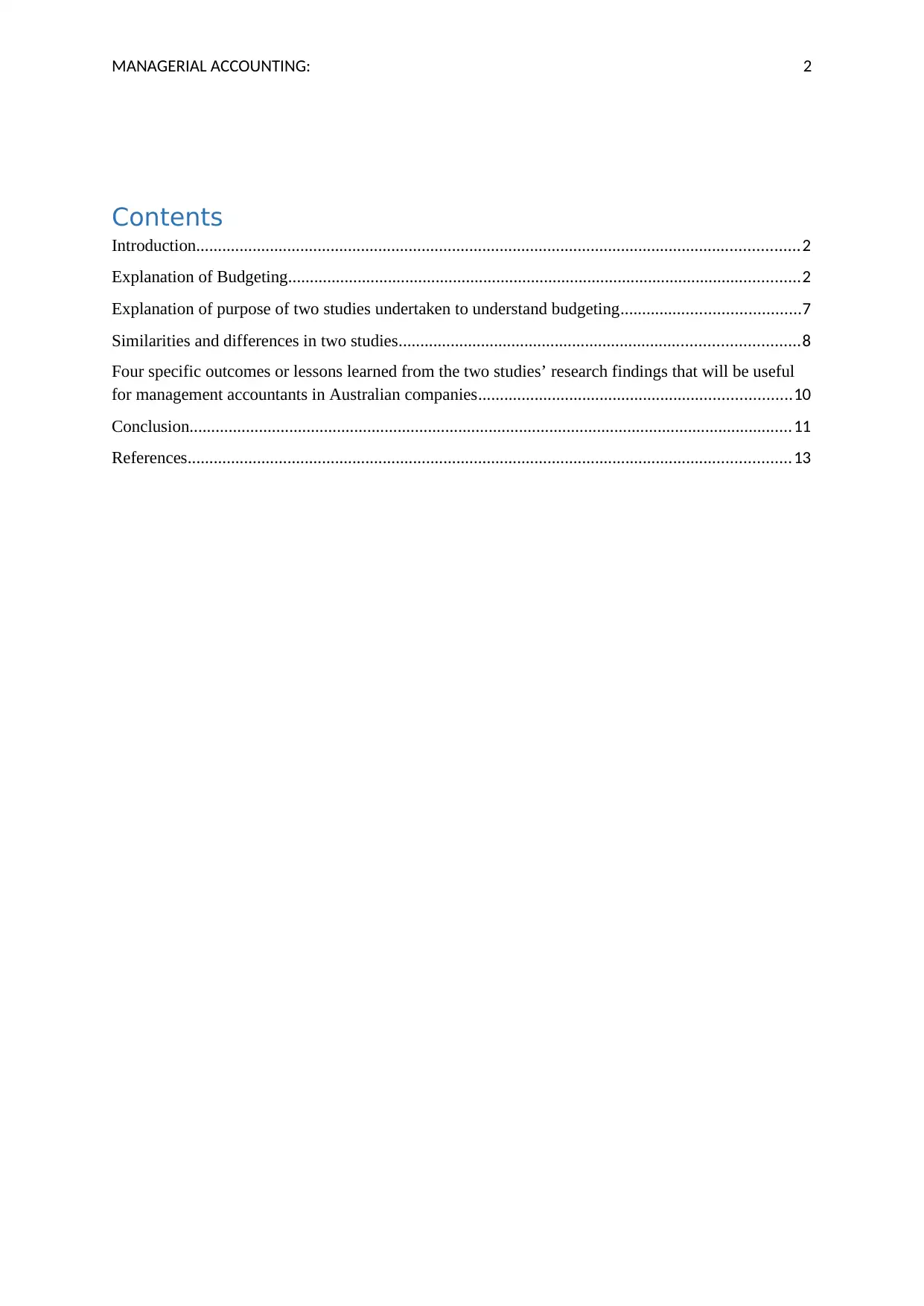
MANAGERIAL ACCOUNTING: 2
Contents
Introduction...........................................................................................................................................2
Explanation of Budgeting......................................................................................................................2
Explanation of purpose of two studies undertaken to understand budgeting.........................................7
Similarities and differences in two studies............................................................................................8
Four specific outcomes or lessons learned from the two studies’ research findings that will be useful
for management accountants in Australian companies........................................................................10
Conclusion...........................................................................................................................................11
References...........................................................................................................................................13
Contents
Introduction...........................................................................................................................................2
Explanation of Budgeting......................................................................................................................2
Explanation of purpose of two studies undertaken to understand budgeting.........................................7
Similarities and differences in two studies............................................................................................8
Four specific outcomes or lessons learned from the two studies’ research findings that will be useful
for management accountants in Australian companies........................................................................10
Conclusion...........................................................................................................................................11
References...........................................................................................................................................13
⊘ This is a preview!⊘
Do you want full access?
Subscribe today to unlock all pages.

Trusted by 1+ million students worldwide
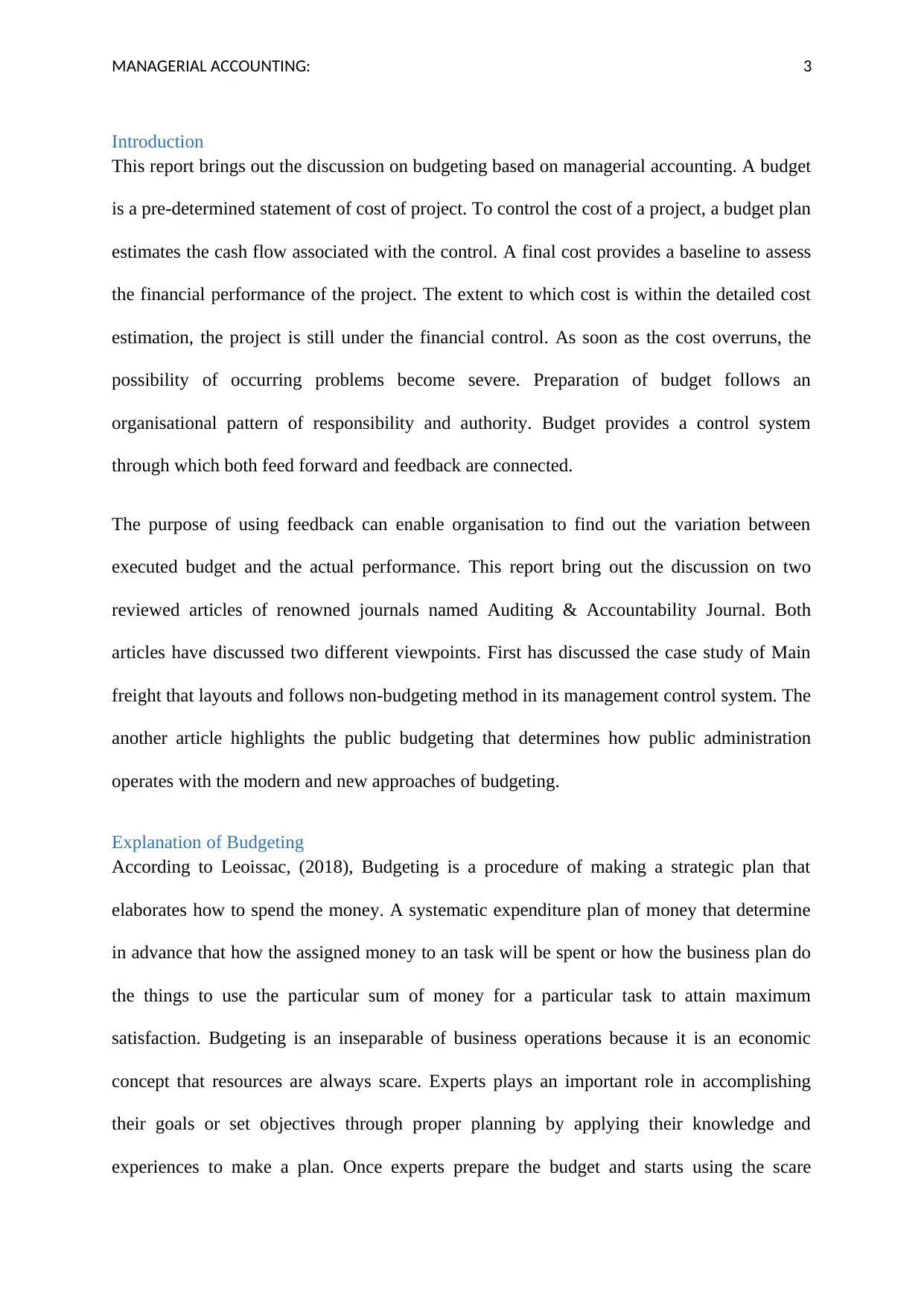
MANAGERIAL ACCOUNTING: 3
Introduction
This report brings out the discussion on budgeting based on managerial accounting. A budget
is a pre-determined statement of cost of project. To control the cost of a project, a budget plan
estimates the cash flow associated with the control. A final cost provides a baseline to assess
the financial performance of the project. The extent to which cost is within the detailed cost
estimation, the project is still under the financial control. As soon as the cost overruns, the
possibility of occurring problems become severe. Preparation of budget follows an
organisational pattern of responsibility and authority. Budget provides a control system
through which both feed forward and feedback are connected.
The purpose of using feedback can enable organisation to find out the variation between
executed budget and the actual performance. This report bring out the discussion on two
reviewed articles of renowned journals named Auditing & Accountability Journal. Both
articles have discussed two different viewpoints. First has discussed the case study of Main
freight that layouts and follows non-budgeting method in its management control system. The
another article highlights the public budgeting that determines how public administration
operates with the modern and new approaches of budgeting.
Explanation of Budgeting
According to Leoissac, (2018), Budgeting is a procedure of making a strategic plan that
elaborates how to spend the money. A systematic expenditure plan of money that determine
in advance that how the assigned money to an task will be spent or how the business plan do
the things to use the particular sum of money for a particular task to attain maximum
satisfaction. Budgeting is an inseparable of business operations because it is an economic
concept that resources are always scare. Experts plays an important role in accomplishing
their goals or set objectives through proper planning by applying their knowledge and
experiences to make a plan. Once experts prepare the budget and starts using the scare
Introduction
This report brings out the discussion on budgeting based on managerial accounting. A budget
is a pre-determined statement of cost of project. To control the cost of a project, a budget plan
estimates the cash flow associated with the control. A final cost provides a baseline to assess
the financial performance of the project. The extent to which cost is within the detailed cost
estimation, the project is still under the financial control. As soon as the cost overruns, the
possibility of occurring problems become severe. Preparation of budget follows an
organisational pattern of responsibility and authority. Budget provides a control system
through which both feed forward and feedback are connected.
The purpose of using feedback can enable organisation to find out the variation between
executed budget and the actual performance. This report bring out the discussion on two
reviewed articles of renowned journals named Auditing & Accountability Journal. Both
articles have discussed two different viewpoints. First has discussed the case study of Main
freight that layouts and follows non-budgeting method in its management control system. The
another article highlights the public budgeting that determines how public administration
operates with the modern and new approaches of budgeting.
Explanation of Budgeting
According to Leoissac, (2018), Budgeting is a procedure of making a strategic plan that
elaborates how to spend the money. A systematic expenditure plan of money that determine
in advance that how the assigned money to an task will be spent or how the business plan do
the things to use the particular sum of money for a particular task to attain maximum
satisfaction. Budgeting is an inseparable of business operations because it is an economic
concept that resources are always scare. Experts plays an important role in accomplishing
their goals or set objectives through proper planning by applying their knowledge and
experiences to make a plan. Once experts prepare the budget and starts using the scare
Paraphrase This Document
Need a fresh take? Get an instant paraphrase of this document with our AI Paraphraser
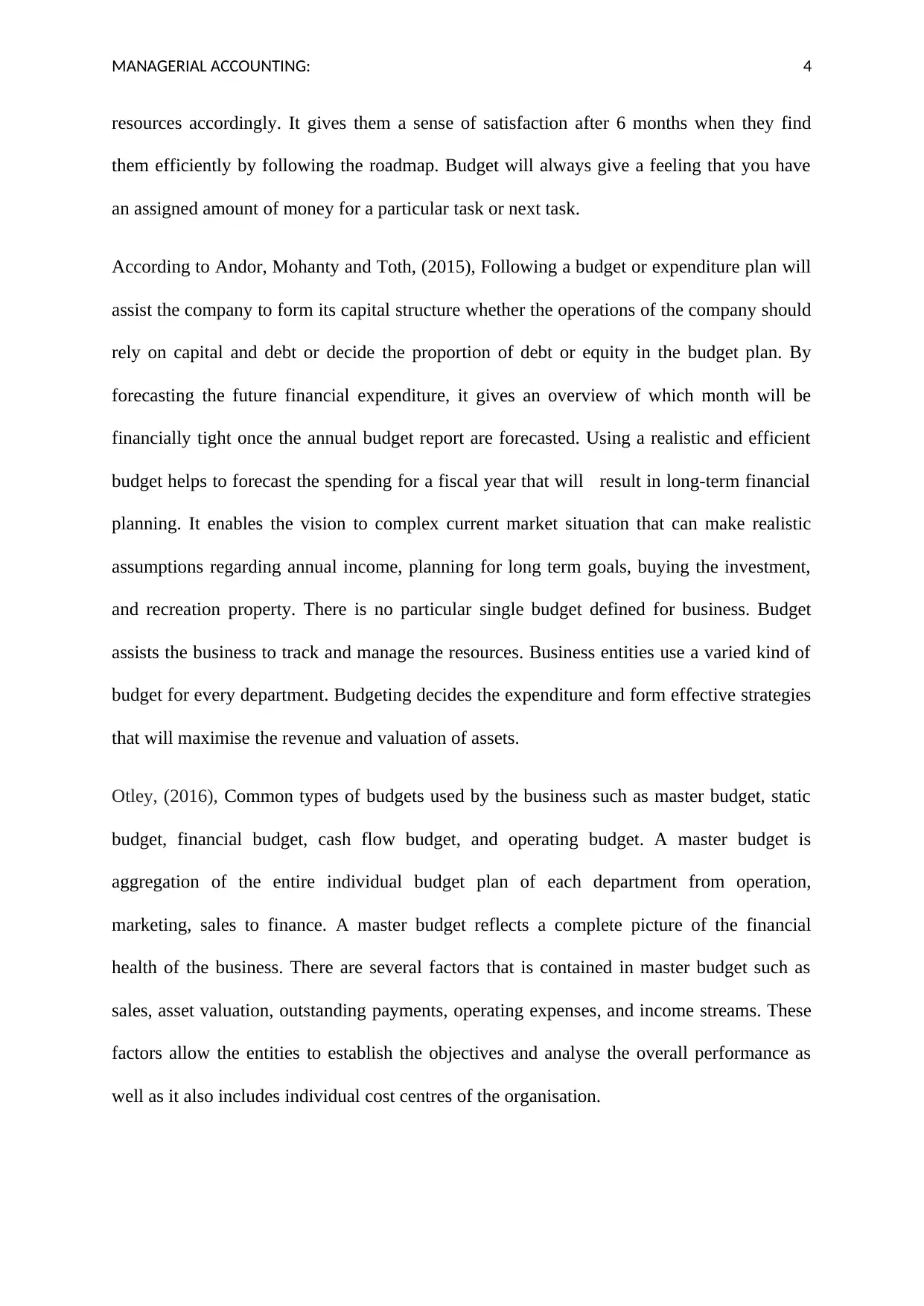
MANAGERIAL ACCOUNTING: 4
resources accordingly. It gives them a sense of satisfaction after 6 months when they find
them efficiently by following the roadmap. Budget will always give a feeling that you have
an assigned amount of money for a particular task or next task.
According to Andor, Mohanty and Toth, (2015), Following a budget or expenditure plan will
assist the company to form its capital structure whether the operations of the company should
rely on capital and debt or decide the proportion of debt or equity in the budget plan. By
forecasting the future financial expenditure, it gives an overview of which month will be
financially tight once the annual budget report are forecasted. Using a realistic and efficient
budget helps to forecast the spending for a fiscal year that will result in long-term financial
planning. It enables the vision to complex current market situation that can make realistic
assumptions regarding annual income, planning for long term goals, buying the investment,
and recreation property. There is no particular single budget defined for business. Budget
assists the business to track and manage the resources. Business entities use a varied kind of
budget for every department. Budgeting decides the expenditure and form effective strategies
that will maximise the revenue and valuation of assets.
Otley, (2016), Common types of budgets used by the business such as master budget, static
budget, financial budget, cash flow budget, and operating budget. A master budget is
aggregation of the entire individual budget plan of each department from operation,
marketing, sales to finance. A master budget reflects a complete picture of the financial
health of the business. There are several factors that is contained in master budget such as
sales, asset valuation, outstanding payments, operating expenses, and income streams. These
factors allow the entities to establish the objectives and analyse the overall performance as
well as it also includes individual cost centres of the organisation.
resources accordingly. It gives them a sense of satisfaction after 6 months when they find
them efficiently by following the roadmap. Budget will always give a feeling that you have
an assigned amount of money for a particular task or next task.
According to Andor, Mohanty and Toth, (2015), Following a budget or expenditure plan will
assist the company to form its capital structure whether the operations of the company should
rely on capital and debt or decide the proportion of debt or equity in the budget plan. By
forecasting the future financial expenditure, it gives an overview of which month will be
financially tight once the annual budget report are forecasted. Using a realistic and efficient
budget helps to forecast the spending for a fiscal year that will result in long-term financial
planning. It enables the vision to complex current market situation that can make realistic
assumptions regarding annual income, planning for long term goals, buying the investment,
and recreation property. There is no particular single budget defined for business. Budget
assists the business to track and manage the resources. Business entities use a varied kind of
budget for every department. Budgeting decides the expenditure and form effective strategies
that will maximise the revenue and valuation of assets.
Otley, (2016), Common types of budgets used by the business such as master budget, static
budget, financial budget, cash flow budget, and operating budget. A master budget is
aggregation of the entire individual budget plan of each department from operation,
marketing, sales to finance. A master budget reflects a complete picture of the financial
health of the business. There are several factors that is contained in master budget such as
sales, asset valuation, outstanding payments, operating expenses, and income streams. These
factors allow the entities to establish the objectives and analyse the overall performance as
well as it also includes individual cost centres of the organisation.

MANAGERIAL ACCOUNTING: 5
(Source: Leoissac, 2018)
While making business plan, a manager calculates the estimated income and expenses to find
out whether the plan would be profitable or not. Forecasting and estimating income and
expenses help the decision maker to try other business plan trials and alternatives. It enables
the manager to calculate opportunity profit from all the available alternatives and options
(Andor, Mohanty, and Toth, 2015).
According to Uyar, (2009), Cash flow budget is projection of the process how and when cash
comes in and flows out from the business in a specific time period. It helps to maintain ratio
analytical performance of current assets of the company. There is an ideal ratio of current
ratio i.e. 1:1. Current ratio is the ability of the company to payment its outstanding expenses
from its liquid assets (cash and cash equivalents and bank). It enables the company to manage
its cash flow wisely. This type of budget considers several factors such as accounts receivable
and accounts payable that helps the company to assess whether the company has an
appropriate sum of liquid cash to continue its operations. This budget formulates the cash
expenditure plan to spend its cash productively and the ability of the action to generate the
cash in future. For example- An infrastructure company uses the cash flow budget to decide
whether it has the ability or enough liquid cash to start a new construction project before they
are paid for their work (ACCA, 2018).
(Source: Leoissac, 2018)
While making business plan, a manager calculates the estimated income and expenses to find
out whether the plan would be profitable or not. Forecasting and estimating income and
expenses help the decision maker to try other business plan trials and alternatives. It enables
the manager to calculate opportunity profit from all the available alternatives and options
(Andor, Mohanty, and Toth, 2015).
According to Uyar, (2009), Cash flow budget is projection of the process how and when cash
comes in and flows out from the business in a specific time period. It helps to maintain ratio
analytical performance of current assets of the company. There is an ideal ratio of current
ratio i.e. 1:1. Current ratio is the ability of the company to payment its outstanding expenses
from its liquid assets (cash and cash equivalents and bank). It enables the company to manage
its cash flow wisely. This type of budget considers several factors such as accounts receivable
and accounts payable that helps the company to assess whether the company has an
appropriate sum of liquid cash to continue its operations. This budget formulates the cash
expenditure plan to spend its cash productively and the ability of the action to generate the
cash in future. For example- An infrastructure company uses the cash flow budget to decide
whether it has the ability or enough liquid cash to start a new construction project before they
are paid for their work (ACCA, 2018).
⊘ This is a preview!⊘
Do you want full access?
Subscribe today to unlock all pages.

Trusted by 1+ million students worldwide

MANAGERIAL ACCOUNTING: 6
As per the perception of JBlöndal et al., (2008), A financial budget brings out the company`s
strategy to manage the assets, income, expense, and cash flow. This budget is used to
establish and reflect a true picture of organisation`s financial health. Financial budget present
a comprehensive and consolidated overview of relative spending of cash to generate cash
from core operations (principlesofaccounting, 2018). For instance- A software company can
use the financial budget to determine the value in relation to public stock offering or
acquisition. An operational budget forecasts and analysis the projected expense and income
in a particular course of action. To reflect a true picture, operating budget account for several
factors such as material costs, production, overhead, labour cost, overhead, and
administrative costs. This is the most active budget that is prepared most frequently on a
regular basis weekly, monthly or annual basis. An analyst compare the operational activity of
each week or month to ensure that a company overspends on supplies of raw material.
In regards to a business organisation, a budget is a broad overview of financial plan to
achieve financial and operational objectives of an organisation. A budget is an roadmap to
organisation`s strategic plan. While developing a budget, a company plans to achieve the
objective of acquisition of business operations and use of its resources. A budget is a valuable
benchmark to decide how well the procedure steps are taken by the management to ensure
that they can achieve the objectives. Budgets enable to coordinate the business activities
between different departments and aligning these activities to picture or make big strategic
plans.
As per the perception of JBlöndal et al., (2008), A financial budget brings out the company`s
strategy to manage the assets, income, expense, and cash flow. This budget is used to
establish and reflect a true picture of organisation`s financial health. Financial budget present
a comprehensive and consolidated overview of relative spending of cash to generate cash
from core operations (principlesofaccounting, 2018). For instance- A software company can
use the financial budget to determine the value in relation to public stock offering or
acquisition. An operational budget forecasts and analysis the projected expense and income
in a particular course of action. To reflect a true picture, operating budget account for several
factors such as material costs, production, overhead, labour cost, overhead, and
administrative costs. This is the most active budget that is prepared most frequently on a
regular basis weekly, monthly or annual basis. An analyst compare the operational activity of
each week or month to ensure that a company overspends on supplies of raw material.
In regards to a business organisation, a budget is a broad overview of financial plan to
achieve financial and operational objectives of an organisation. A budget is an roadmap to
organisation`s strategic plan. While developing a budget, a company plans to achieve the
objective of acquisition of business operations and use of its resources. A budget is a valuable
benchmark to decide how well the procedure steps are taken by the management to ensure
that they can achieve the objectives. Budgets enable to coordinate the business activities
between different departments and aligning these activities to picture or make big strategic
plans.
Paraphrase This Document
Need a fresh take? Get an instant paraphrase of this document with our AI Paraphraser
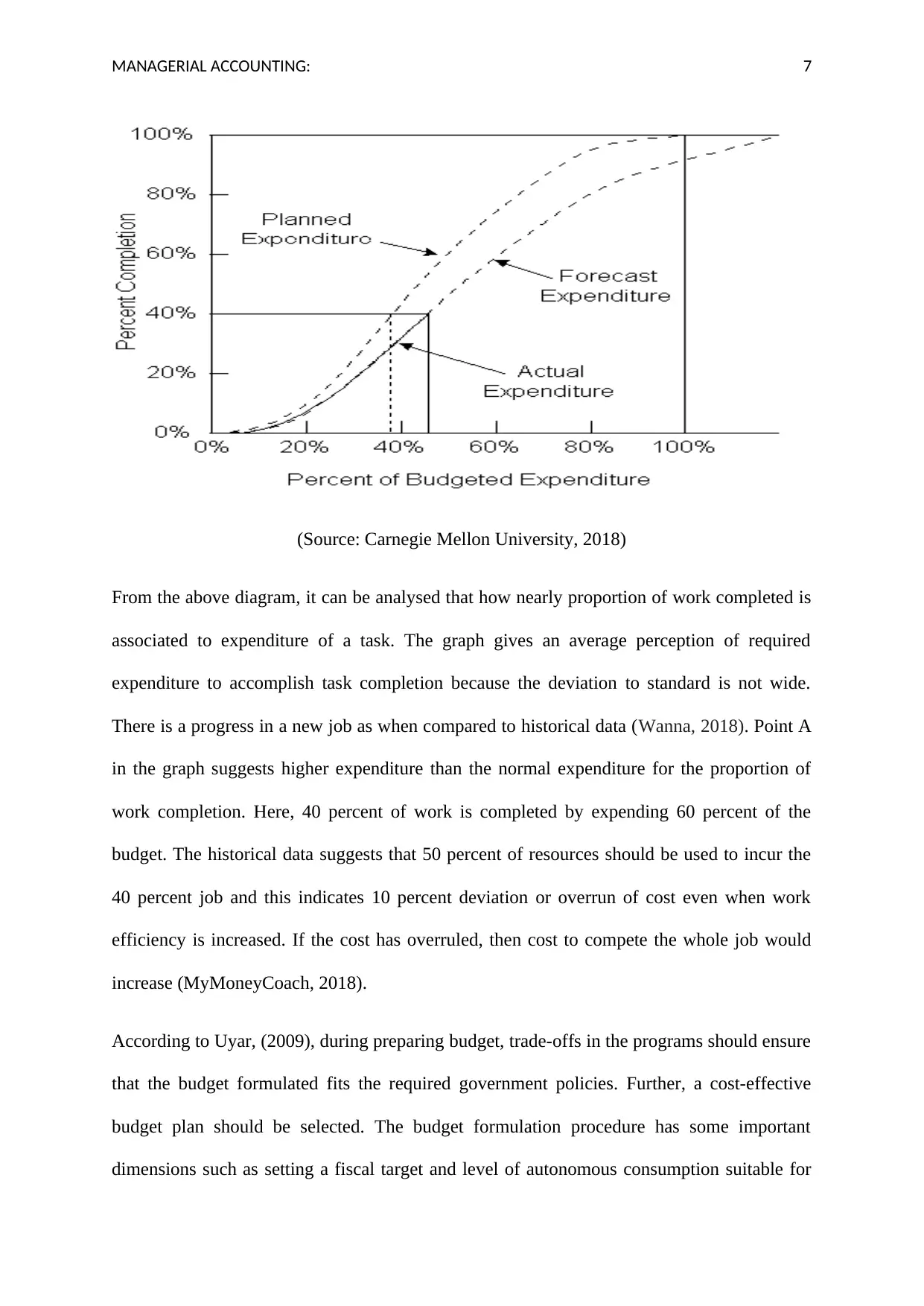
MANAGERIAL ACCOUNTING: 7
(Source: Carnegie Mellon University, 2018)
From the above diagram, it can be analysed that how nearly proportion of work completed is
associated to expenditure of a task. The graph gives an average perception of required
expenditure to accomplish task completion because the deviation to standard is not wide.
There is a progress in a new job as when compared to historical data (Wanna, 2018). Point A
in the graph suggests higher expenditure than the normal expenditure for the proportion of
work completion. Here, 40 percent of work is completed by expending 60 percent of the
budget. The historical data suggests that 50 percent of resources should be used to incur the
40 percent job and this indicates 10 percent deviation or overrun of cost even when work
efficiency is increased. If the cost has overruled, then cost to compete the whole job would
increase (MyMoneyCoach, 2018).
According to Uyar, (2009), during preparing budget, trade-offs in the programs should ensure
that the budget formulated fits the required government policies. Further, a cost-effective
budget plan should be selected. The budget formulation procedure has some important
dimensions such as setting a fiscal target and level of autonomous consumption suitable for
(Source: Carnegie Mellon University, 2018)
From the above diagram, it can be analysed that how nearly proportion of work completed is
associated to expenditure of a task. The graph gives an average perception of required
expenditure to accomplish task completion because the deviation to standard is not wide.
There is a progress in a new job as when compared to historical data (Wanna, 2018). Point A
in the graph suggests higher expenditure than the normal expenditure for the proportion of
work completion. Here, 40 percent of work is completed by expending 60 percent of the
budget. The historical data suggests that 50 percent of resources should be used to incur the
40 percent job and this indicates 10 percent deviation or overrun of cost even when work
efficiency is increased. If the cost has overruled, then cost to compete the whole job would
increase (MyMoneyCoach, 2018).
According to Uyar, (2009), during preparing budget, trade-offs in the programs should ensure
that the budget formulated fits the required government policies. Further, a cost-effective
budget plan should be selected. The budget formulation procedure has some important
dimensions such as setting a fiscal target and level of autonomous consumption suitable for

MANAGERIAL ACCOUNTING: 8
these targets, which always remained an objective to be achieved in macro-economic
framework. Moreover, there is a need to form a policy regarding the expenditures such as
adequate allocation of resources with confirming both polices and the fiscal targets that
remains the main objective and the core process of preparing budgets. Finally, budget
addresses the operational efficiency and sort the performance issues (Carnegie, Christopher,
and Napier, 2017).
Explanation of purpose of two studies undertaken to understand budgeting
In context to managing a business organisation, there are mainly three purposes to formulate
budget plan such as a forecast of income and expenditure statements. It act as a tool for
decision-making and a mode to check business performance. The purpose of two studies is
based on two different articles based on budgeting. The first article evaluates the budgeting
approaches such as traditional budgeting, improving budgeting system, and making decision
beyond budgeting. The research articles outlays review on case study of Main freight that
was never based on traditional budgeting. Moreover, it also covers the new approaches of
budgeting. This article view budget as a central component of (MCS) management control
systems. This beyond budgeting system opposes that manager should develop employ more
control system to replace budgets. This article examines the MCS (management control
system) which never engaged tradition system of budgeting (Grady and Akroyd, 2016).
Another article from Accounting, Auditing & Accountability Journal purposes budgeting as a
central concept in public organisation. According to the researcher, budgeting is a
multifaceted and knowledge rich topic to research on. The changing institutional, social, and
economic needs, it require assessing the role, and featuring while assessing the accounting
studies with the topic. The purpose is to review the public budgeting that determines how
public management and public administration engage the traditional as well as modern
budgeting theories in contribute a long-term sustainability of business.
these targets, which always remained an objective to be achieved in macro-economic
framework. Moreover, there is a need to form a policy regarding the expenditures such as
adequate allocation of resources with confirming both polices and the fiscal targets that
remains the main objective and the core process of preparing budgets. Finally, budget
addresses the operational efficiency and sort the performance issues (Carnegie, Christopher,
and Napier, 2017).
Explanation of purpose of two studies undertaken to understand budgeting
In context to managing a business organisation, there are mainly three purposes to formulate
budget plan such as a forecast of income and expenditure statements. It act as a tool for
decision-making and a mode to check business performance. The purpose of two studies is
based on two different articles based on budgeting. The first article evaluates the budgeting
approaches such as traditional budgeting, improving budgeting system, and making decision
beyond budgeting. The research articles outlays review on case study of Main freight that
was never based on traditional budgeting. Moreover, it also covers the new approaches of
budgeting. This article view budget as a central component of (MCS) management control
systems. This beyond budgeting system opposes that manager should develop employ more
control system to replace budgets. This article examines the MCS (management control
system) which never engaged tradition system of budgeting (Grady and Akroyd, 2016).
Another article from Accounting, Auditing & Accountability Journal purposes budgeting as a
central concept in public organisation. According to the researcher, budgeting is a
multifaceted and knowledge rich topic to research on. The changing institutional, social, and
economic needs, it require assessing the role, and featuring while assessing the accounting
studies with the topic. The purpose is to review the public budgeting that determines how
public management and public administration engage the traditional as well as modern
budgeting theories in contribute a long-term sustainability of business.
⊘ This is a preview!⊘
Do you want full access?
Subscribe today to unlock all pages.

Trusted by 1+ million students worldwide
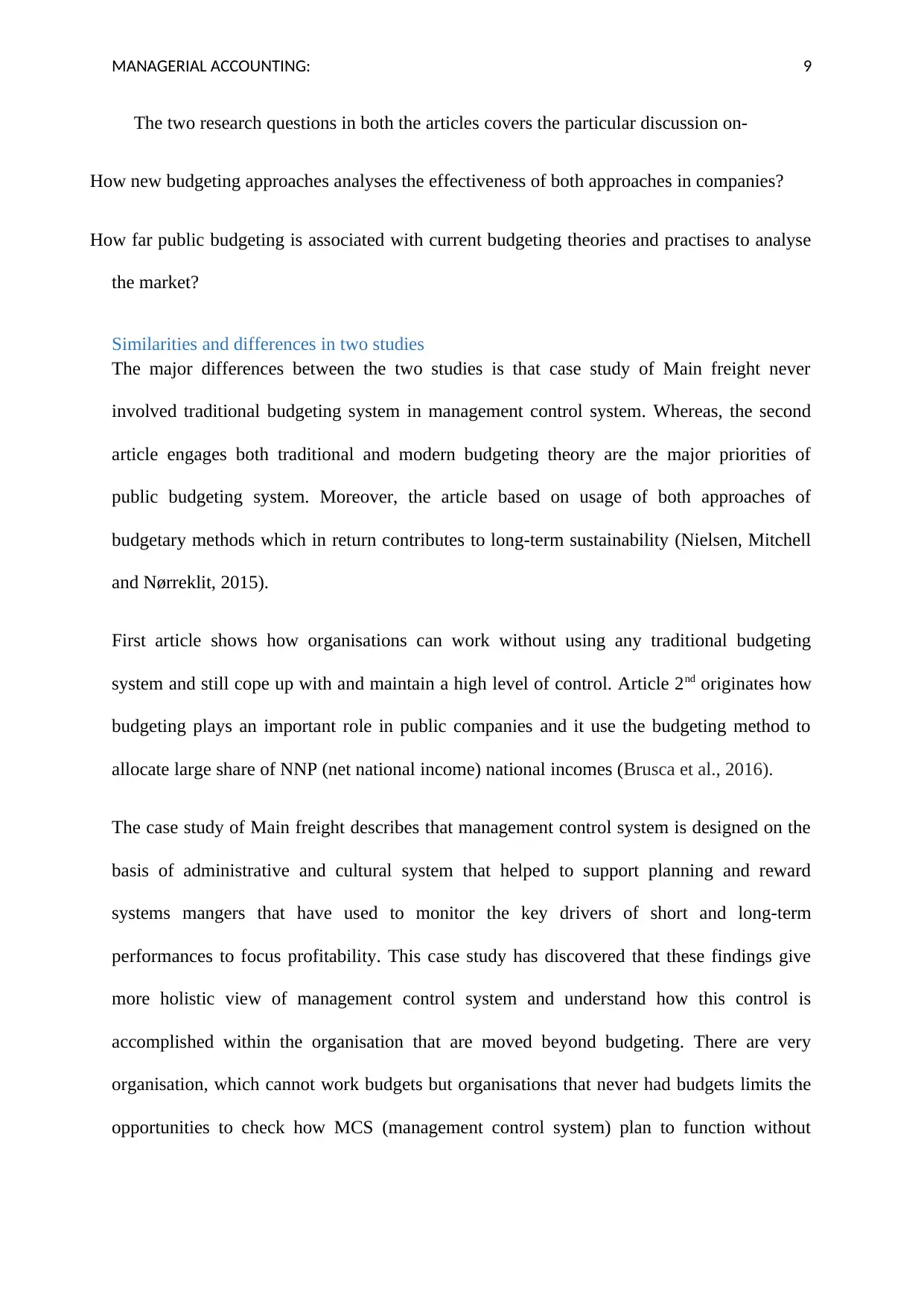
MANAGERIAL ACCOUNTING: 9
The two research questions in both the articles covers the particular discussion on-
How new budgeting approaches analyses the effectiveness of both approaches in companies?
How far public budgeting is associated with current budgeting theories and practises to analyse
the market?
Similarities and differences in two studies
The major differences between the two studies is that case study of Main freight never
involved traditional budgeting system in management control system. Whereas, the second
article engages both traditional and modern budgeting theory are the major priorities of
public budgeting system. Moreover, the article based on usage of both approaches of
budgetary methods which in return contributes to long-term sustainability (Nielsen, Mitchell
and Nørreklit, 2015).
First article shows how organisations can work without using any traditional budgeting
system and still cope up with and maintain a high level of control. Article 2nd originates how
budgeting plays an important role in public companies and it use the budgeting method to
allocate large share of NNP (net national income) national incomes (Brusca et al., 2016).
The case study of Main freight describes that management control system is designed on the
basis of administrative and cultural system that helped to support planning and reward
systems mangers that have used to monitor the key drivers of short and long-term
performances to focus profitability. This case study has discovered that these findings give
more holistic view of management control system and understand how this control is
accomplished within the organisation that are moved beyond budgeting. There are very
organisation, which cannot work budgets but organisations that never had budgets limits the
opportunities to check how MCS (management control system) plan to function without
The two research questions in both the articles covers the particular discussion on-
How new budgeting approaches analyses the effectiveness of both approaches in companies?
How far public budgeting is associated with current budgeting theories and practises to analyse
the market?
Similarities and differences in two studies
The major differences between the two studies is that case study of Main freight never
involved traditional budgeting system in management control system. Whereas, the second
article engages both traditional and modern budgeting theory are the major priorities of
public budgeting system. Moreover, the article based on usage of both approaches of
budgetary methods which in return contributes to long-term sustainability (Nielsen, Mitchell
and Nørreklit, 2015).
First article shows how organisations can work without using any traditional budgeting
system and still cope up with and maintain a high level of control. Article 2nd originates how
budgeting plays an important role in public companies and it use the budgeting method to
allocate large share of NNP (net national income) national incomes (Brusca et al., 2016).
The case study of Main freight describes that management control system is designed on the
basis of administrative and cultural system that helped to support planning and reward
systems mangers that have used to monitor the key drivers of short and long-term
performances to focus profitability. This case study has discovered that these findings give
more holistic view of management control system and understand how this control is
accomplished within the organisation that are moved beyond budgeting. There are very
organisation, which cannot work budgets but organisations that never had budgets limits the
opportunities to check how MCS (management control system) plan to function without
Paraphrase This Document
Need a fresh take? Get an instant paraphrase of this document with our AI Paraphraser
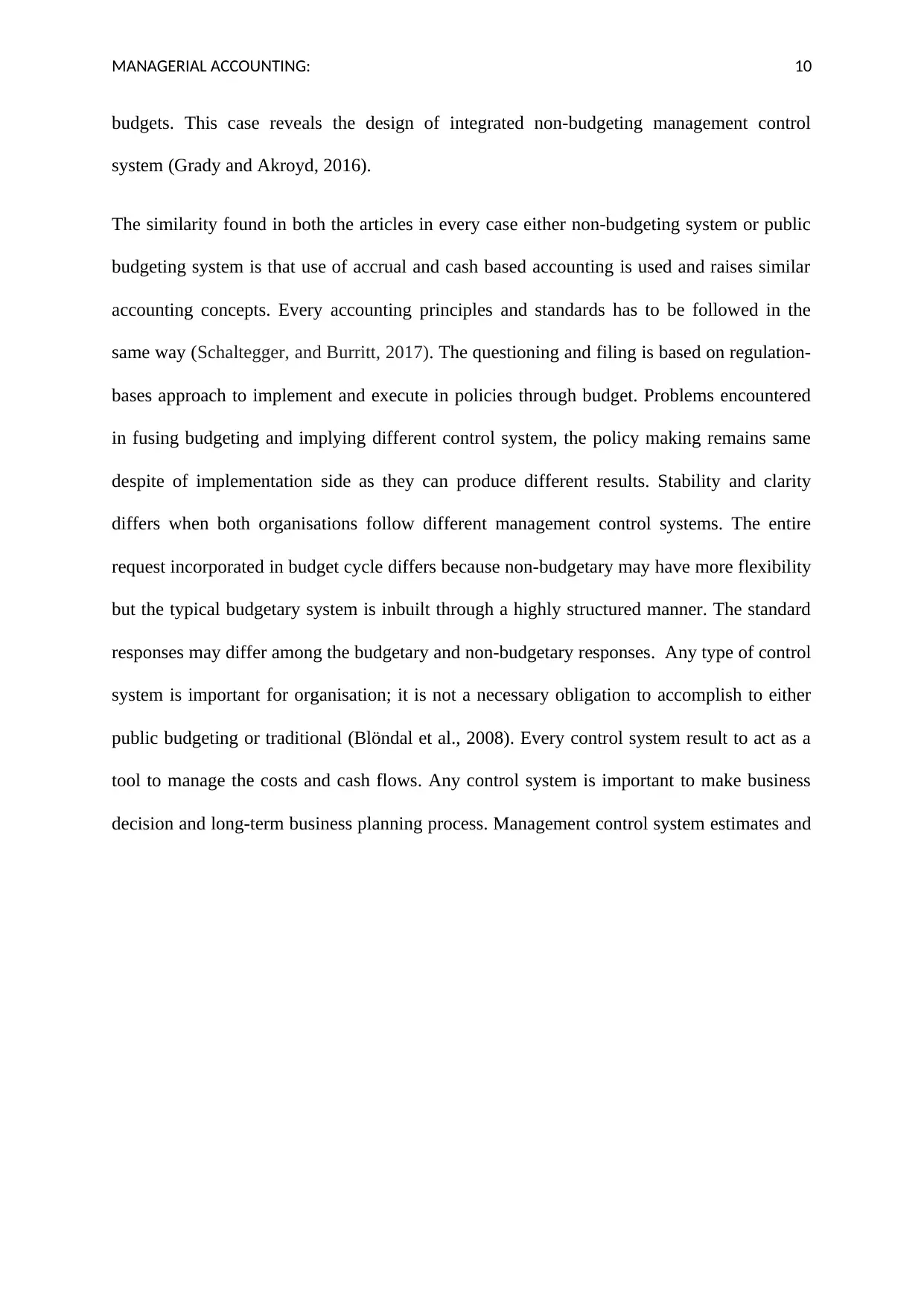
MANAGERIAL ACCOUNTING: 10
budgets. This case reveals the design of integrated non-budgeting management control
system (Grady and Akroyd, 2016).
The similarity found in both the articles in every case either non-budgeting system or public
budgeting system is that use of accrual and cash based accounting is used and raises similar
accounting concepts. Every accounting principles and standards has to be followed in the
same way (Schaltegger, and Burritt, 2017). The questioning and filing is based on regulation-
bases approach to implement and execute in policies through budget. Problems encountered
in fusing budgeting and implying different control system, the policy making remains same
despite of implementation side as they can produce different results. Stability and clarity
differs when both organisations follow different management control systems. The entire
request incorporated in budget cycle differs because non-budgetary may have more flexibility
but the typical budgetary system is inbuilt through a highly structured manner. The standard
responses may differ among the budgetary and non-budgetary responses. Any type of control
system is important for organisation; it is not a necessary obligation to accomplish to either
public budgeting or traditional (Blöndal et al., 2008). Every control system result to act as a
tool to manage the costs and cash flows. Any control system is important to make business
decision and long-term business planning process. Management control system estimates and
budgets. This case reveals the design of integrated non-budgeting management control
system (Grady and Akroyd, 2016).
The similarity found in both the articles in every case either non-budgeting system or public
budgeting system is that use of accrual and cash based accounting is used and raises similar
accounting concepts. Every accounting principles and standards has to be followed in the
same way (Schaltegger, and Burritt, 2017). The questioning and filing is based on regulation-
bases approach to implement and execute in policies through budget. Problems encountered
in fusing budgeting and implying different control system, the policy making remains same
despite of implementation side as they can produce different results. Stability and clarity
differs when both organisations follow different management control systems. The entire
request incorporated in budget cycle differs because non-budgetary may have more flexibility
but the typical budgetary system is inbuilt through a highly structured manner. The standard
responses may differ among the budgetary and non-budgetary responses. Any type of control
system is important for organisation; it is not a necessary obligation to accomplish to either
public budgeting or traditional (Blöndal et al., 2008). Every control system result to act as a
tool to manage the costs and cash flows. Any control system is important to make business
decision and long-term business planning process. Management control system estimates and
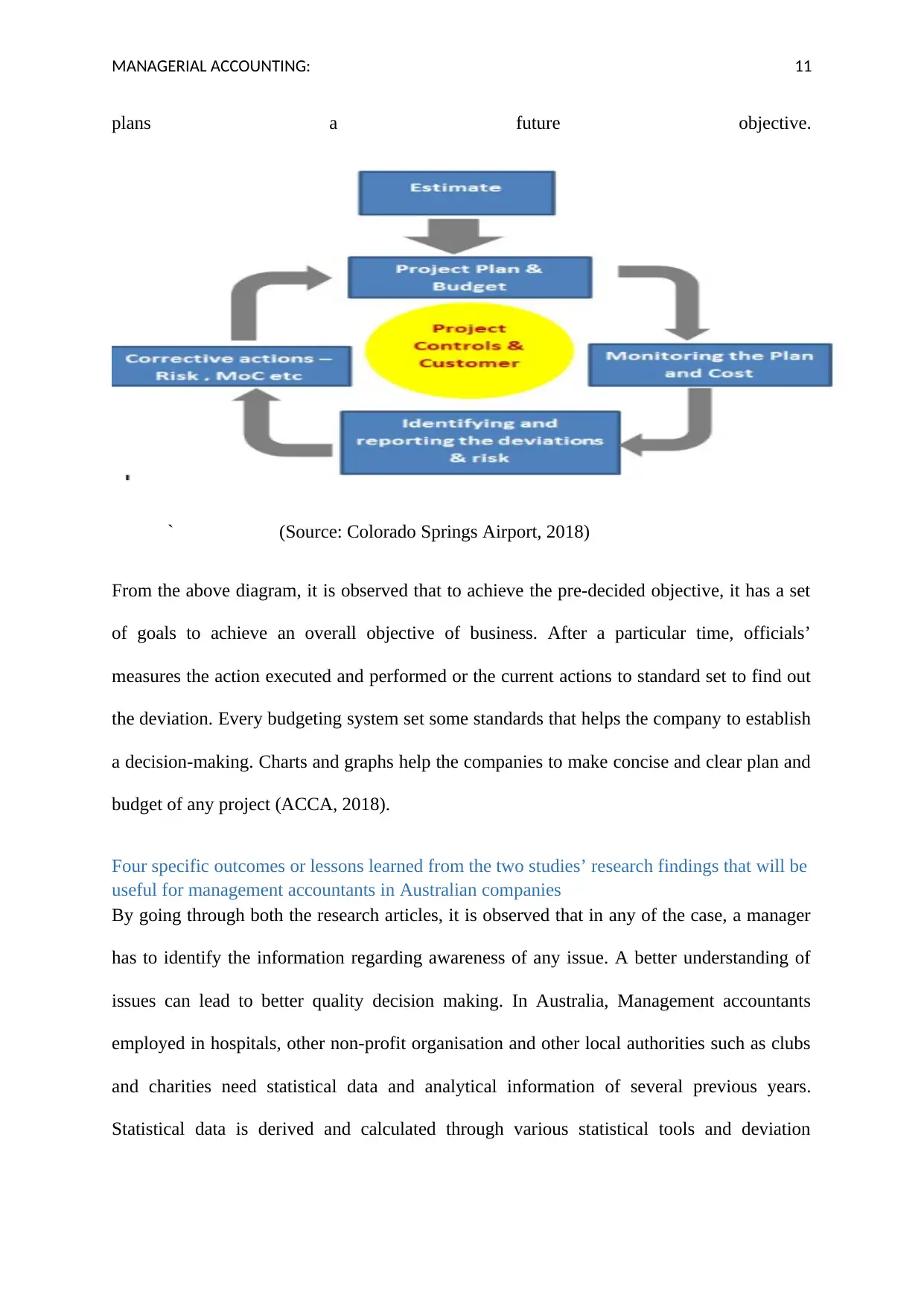
MANAGERIAL ACCOUNTING: 11
plans a future objective.
` (Source: Colorado Springs Airport, 2018)
From the above diagram, it is observed that to achieve the pre-decided objective, it has a set
of goals to achieve an overall objective of business. After a particular time, officials’
measures the action executed and performed or the current actions to standard set to find out
the deviation. Every budgeting system set some standards that helps the company to establish
a decision-making. Charts and graphs help the companies to make concise and clear plan and
budget of any project (ACCA, 2018).
Four specific outcomes or lessons learned from the two studies’ research findings that will be
useful for management accountants in Australian companies
By going through both the research articles, it is observed that in any of the case, a manager
has to identify the information regarding awareness of any issue. A better understanding of
issues can lead to better quality decision making. In Australia, Management accountants
employed in hospitals, other non-profit organisation and other local authorities such as clubs
and charities need statistical data and analytical information of several previous years.
Statistical data is derived and calculated through various statistical tools and deviation
plans a future objective.
` (Source: Colorado Springs Airport, 2018)
From the above diagram, it is observed that to achieve the pre-decided objective, it has a set
of goals to achieve an overall objective of business. After a particular time, officials’
measures the action executed and performed or the current actions to standard set to find out
the deviation. Every budgeting system set some standards that helps the company to establish
a decision-making. Charts and graphs help the companies to make concise and clear plan and
budget of any project (ACCA, 2018).
Four specific outcomes or lessons learned from the two studies’ research findings that will be
useful for management accountants in Australian companies
By going through both the research articles, it is observed that in any of the case, a manager
has to identify the information regarding awareness of any issue. A better understanding of
issues can lead to better quality decision making. In Australia, Management accountants
employed in hospitals, other non-profit organisation and other local authorities such as clubs
and charities need statistical data and analytical information of several previous years.
Statistical data is derived and calculated through various statistical tools and deviation
⊘ This is a preview!⊘
Do you want full access?
Subscribe today to unlock all pages.

Trusted by 1+ million students worldwide
1 out of 17
Related Documents
Your All-in-One AI-Powered Toolkit for Academic Success.
+13062052269
info@desklib.com
Available 24*7 on WhatsApp / Email
![[object Object]](/_next/static/media/star-bottom.7253800d.svg)
Unlock your academic potential
Copyright © 2020–2025 A2Z Services. All Rights Reserved. Developed and managed by ZUCOL.




